#beginner projects
Explore tagged Tumblr posts
Text
Making simple pouches from scraps
This started as a comment about simple projects for beginner sewists, but it got a bit out of hand, so I decided to drop it on this blog with illustrations for easier reference!
The result are pouches that I use to organize small things like the items in my daily carry bag (e.g. pens, medicine/toiletries) or regularly packed items that I would like to be able to grab quickly to bring to certain outings (e.g. dice bag for roleplay).
Generally, there are four kinds of pouches I have made from scraps:
A flat, rectangular drawstring bag, good for small items like e.g. tampons, band aids, pill blisters. We're going to discuss two variations, one of which is a little easier (a) and one that IMHO looks a little better (b).
A flat, equally rectangular zipper bag, good for pens or makeup.
A circle drawstring bag, good as a smaller dice bag or as a gift bag, imho.
A circle drawstring bag with a flat bottom. A bit more complicated, but better for bigger dice collections. Because we greedy gremlins need space for all our shiny click-clacks, don't we ;)
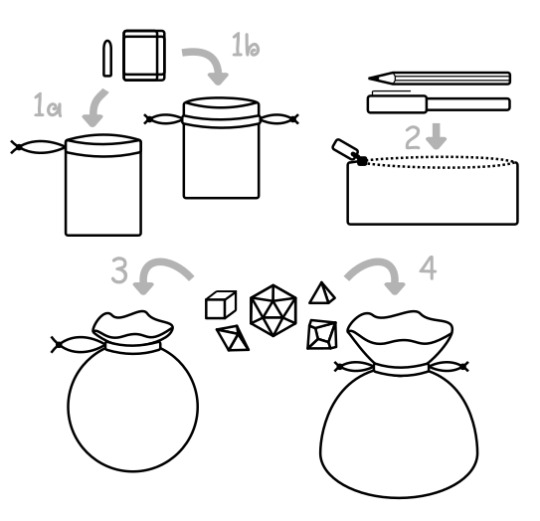
1. Flat Drawstring Pouch
These are super easy in my opinion. You’ll need either a single piece that is significantly wider than it is high, which I usually make into version a or two scraps in about the same size, which I like to use for version b.
For version a, to make it a drawstring, we fold over the top edge (about 1,5cm/half an inch is usually enough) to the inside and sew that down close to that folded down fabric edge.
For version b, do the same for both pieces, but the fold over needs to be a bit bigger (about 3cm/an inch) as you need a little more space. Sew this down the same as version a, but add a second seam above, with a distance of about 1cm (~3/8th inch). If you have a twin needle, this might also be a use for it.

Then, for version a, you fold the wide piece in half and for version b you lay the two pieces on top of each other, outsides together in both cases. And then you sew shut all the sides you want to be closed.
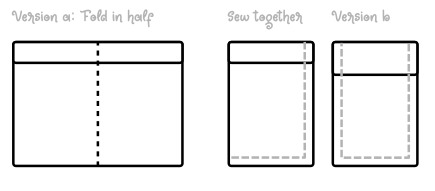
Turn it inside out and – using a seam ripper or pair of snips – cut holes into the outer layer of fabric on each side of each side seam.
This means two holes for version a between the seam and top edge and four holes for version b, between the two seams.

(Only one side each depicted here, do the same on the back.)
Then you can thread a string or ribbon into one of the holes and through the channels you have sewn. I tie the string to a small safety pin as it is easier to push through the channel from the outside.
For version b you can either use two strings (one for each side) or one long one to go all the way around (by going out the hole on one side of the side seam and going into the one on the other side of the side seam).
Tie up the ends of your strings and you’ve got your drawstring bag!
2. Flat Zipper Bag
As a note: The zipper might prove challenging. However, it does present a great opportunity to try your hand on this dreaded piece of haberdashery. To make things easier on yourself I would recommend to avoid invisible or separating zippers and to make sure they’re not shorter than the longest item (e.g. the longest pen) you would like to fit through it.
Aside from the zipper you will need a roughly square piece of fabric. I usually just use the zipper as a ruler for one side, making sure that the whole scrap (so including seam allowance) is the same length as the tape. If you don’t quite have that, take e.g. the noted longest pen as reference and, as illustrated below, make sure that (in addition to seam allowance) one side of the square is the length of the pencil (L) and two of its heights (H).
The other side determines how much space we have in the pouch. So for our example we want it to be at least three pencil heights plus one extra for wiggle room (so 4*H). But we need this measure twice because a pouch generally has at least two sides, so all in all we’re at 8*H. Or you use whatever you have as long as it’s bigger than that. ;)

First of all we sew the zipper in. We determine the outside of both the zipper and the fabric and put them against each other, with one of the outer edges of the zipper tape aligned with the side that is supposed to be the opening. Pin it, then you sew it on with a straight stitch. If you’re using a normal foot (in contrast to a zipper foot, which should come with its own instructions), you can usually let it run along the teeth, as that will provide a great ruler to not get any wobbliness in your seam.

Tip: Make sure you’re not sewing too close to the zipper’s slider. I usually push it all the way to the opposing end of the zipper when I start sewing and when I’m halfway, I sink my needle into the fabric, lift the sewing foot and pull the slider all the way to the already sewn end before I lower the foot again and proceed to sew the other half.
You’ve attached one side of the zipper! Great! Now do the same thing on the other side, still making sure to lay outsides onto each other. You will end up with what looks like a zippable tube with the slider on the inside. Flatten the tube, pin it closed if necessary (the zipper tape might be a bit stubborn) and sew it close on both ends. (Careful to move the slider away from your needle!)

I like my zipper on one edge, but you can just as well flatten the tube so the zipper is centered on one of the sides.
Turn the whole thing inside out and TADA! Zipper pouch!
3. Circular Drawstring Pouch
This pouch is probably the easiest of the pouches as you only have to sew a channel around the edge and draw a string through. That channel, however, is basically a hem on a small circle. Which will prepare you for the pain of hemming circle skirts ;)
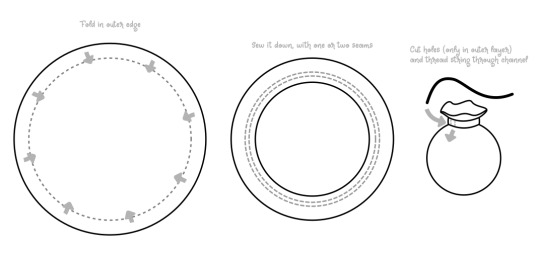
Once again you will have to cut holes for the drawstring to go in and it is fully a matter of taste if you do more than two holes, but they should be an even number.
4. Drawstring Pouch With Flat Bottom
This pouch has similarities with the other draw string pouch, but because of the flat bottom it is the only one that will stand on its own, which makes it a good shape for a bigger pouch. Nevertheless, it is still a good scrap project!
You will need a circular piece and a strip that is the length of the circle’s circumference and at least the height of the circle’s radius 6 cm / 2 inches.
(If you struggle to find the circle’s circumference and radius, I included the equations for both in the illustration below. The Diameter can be measured by folding the circle in half and measuring the fold.)
Fold over one of the long (top) edges and sew drawstring channels as described for the flat pouches. Then lay the bottom edge along the edge of the circle, pin and sew them together. You will hate it, as flats sewn to curves is the point of this, but it’s worth the effort.

Finally, sew the two short edges of the strip together and turn the bag inside out.
Once again, you will have to add a drawstring, but it is up to you how many holes you cut for it, 2 or more, buit an even number.
8 notes
·
View notes
Text
Beginner-Friendly Projects in Private Sewing Lessons
Hey there, sewing enthusiasts! Are you ready to embark on a stitching journey with private sewing lessons? Whether you’re a beginner just dipping your toes into the magical world of sewing or have some experience, private lessons are a fantastic way to hone your skills and learn at your own pace. So, let’s dive into some beginner sewing projects that are perfect for private sewing lessons. Get…

View On WordPress
#beginner private lesson projects#beginner projects#jesy anderson#learn to sew#learn to sew in dayton#needle ink and thread#needleinkandthread#private sewing lesson projects#projects for private sewing lessons#projects that are good for private sewing lessons#sew dayton#sewing#sewing classes near me
0 notes
Text
Nothing about how I feel about you has changed.
i wasn't gonna post this part of the chapter bc it was too long but. i truly cannot stop thinking about it. im unwell.
dabbled in translating and it was fun!! this was translated and edited by me and pls do not repost this, at least until the event is over!! thank you!
#pls im a beginner in japanese why am i doing this lmao#ena5#project sekai#mizuena#niigo#mizuki akiyama#ena shinonome#ena5 spoilers#project sekai spoilers#n25#prsk#mzen#mine#mzen posting
440 notes
·
View notes
Text
First Quilt!
It has been a lot of fun and a lot of trial and error but it's done!!!



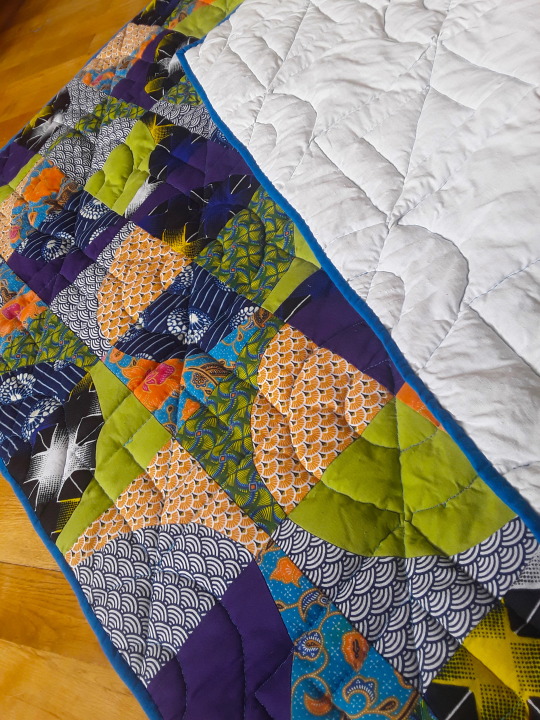
It's roughly 1.20 x 1.20m (which is a number of feet I can't be bothered to look up but let's say it's about child sized and it'll be great to chill on the couch).
I want to thank @langdon813 who I've never talked to (sorry if you hate being tagged) but whose gorgeous Drunkard path quilts made me wanna do it too :)
I had never done any quilting before (but I did sew), so here's what I've learned, if any beginner is interested in jumping off the deep end the way I did and wants advice from someone who has freshly acquired experience but will also not use any confusing technical terms (with pictures!) :
Fabric picking : so most advice I read was to go for pre-selected bundles of fabric that already go together, but I'm contrary and like to do my own thing so I used wax fabric (the blue ones on top the pile) I had laying around, which I strongly recommend: it's very easy to cut due to it being waxed, and I added a few fat squares from the shop, plus I also had the orange and blue floral and I based the coulour scheme on it. One thing that's true is it would have been easier to work with fabric of the same thickness, and the floral was givne to me by my ma who got in on trip to Thailand and it was alot thinner than the rest which didn't help.

Cutting: I got a rotary cutter for the occasion and it's great! Do not maybe push too hard on it and give yourself nerve damage the way I did (temporary but still), it's actually ery sharp and easy to use, so long as your template doesn't slip you're fine
Piecing :Yes you can do curved piecing even if you have zero experience, you just gotta make a template and
pin it a lot.
1/4 inch margins is the standard so I rolled with it because I don't like converting, but when you're strictly metric it is kind of annoying but doable because my machine does have a 1/4 inch mark and if you stick a length of tape along it it's pretty easy to follow, even for curved piecing.
Layout: At some point you've got to decide the layout is done, because I've re-arranged the blocks at least 6 times and it's a very good way to go insane. (For rough reference, my plan was to have no repeat fabrics in any of the circle-in-a-square blocks, and I only made one mistake which I clocked too late to change)

Chain piecing!! Meaning you pile your blocks together in a specific order (that I personnaly wrote straight up on each piece with a very sophisticated letter/numbers down/across system) and then just sew them together in a line without having to cut the thread between each pair. Looks a little like a fanion banner and at some point it feels like you'll be forever tangled into it but then it's magic :) It's not that hard actually and will save you a lot of time + there's a lot of online tutorials you can use.
Basting! (which it took me while to understand is the part where you attach the backing, the fluff and the quilt top together) : you need more safety pins. Safety pins will save you from the wrinkles and the unfortunate oopsies of realising you've caught your backing double folded into your quilting stitch, which I did a good three times and was not fun to undo. Also, I forgot to tape the backing to the floor and it probably would have helped with the wrinkling...
Backing : I used an old linen table cloth I got for 10€ at a charity shop, and I've still got about 2/3 of it left, so I recommend that, it's sturdy but soft enough, doesn't thread easily and can be washed at very high temps, if that's a thing you do.
Quilting! Well, my machine came with a quilting foot for free motion quilting (which means you're the one moving the fabric along in whichever direction and you can sort of draw with your stitches) and it seemed fun so I did that, and here's what I learned : curves are hard but doable, also my machine doesn't like to go back (kept skipping sitiches for some reason) so it involves a lot of shifting the quilt around, which isn't easy considering the bulk. And also, drawing the quilting pattern you want so you can follow it while quilting actually does help, I used an iron/heat-erasable pen and it worked just fine. Check your stitch tension, mine was too loose and I realised too late so there's spots where I could pull on the thread and it looped, had to stitch back over that.
Quilitng pattern : I wasn't sure what to do, supposedly your batting (aka: the fluff) comes with instructions on how tight you should quilt to avoid it coming apart through use but I got mine cut at the fabric shop and forgot to ask so I just rolled with a rough 10cm maximum distance in between stitching lines but tried to do less in most places. According to many blogs : the tighter your lines the stiffer your quilt, so I kept it loose for comfort. (Picture is halfway done, I added a smaller square/circle inside each square/circle and if you look at it you'll see it's actually diagonal lines form one end of the fabric to the other.)

Binding is boring, and there's nothing to it. I got a length of pre-cut bias binding, machine-sewed it front to front to the quilt top side of the quilt and the folded it back and secured it by hand to the back with a ladder stitch. Took me roughly and entire rewatch of the Last Of Us. There's a trick to doing the corners that's fairly simple but I've lost the tutorial...
Overall : I got myself a quilting book with techinques and such and it helped, but there's a ton of stuff online, and once you get over the very Christian American mum vibe of most of the blogs, it's all very helpful (and gorgeous!) (no offense meant to Christian American mums, it's just a bit of a culture shock from where I'm standing).
#quilting#quilters of tumblr#quiltblr#quilt tutorial#quilt pattern#quilt#drunkard path#home sewing#sewing#sewing project#beginner's quilt#beginner quilting
181 notes
·
View notes
Text
I finish one knitting project and suddenly I get delusions of grandeur about what I should do next. I made one nice-looking hat and I'm chomping at the bit to jump right into a whole ass sweater. I DO have the confidence of a mediocre white man but only immediately upon finishing a craft project.
#in fairness the hat looks SO nice and the sweater is very much a beginner project so#also I already have half the yarn for it#so really this is very reasonable#i need two skeins and a circular needle
254 notes
·
View notes
Text
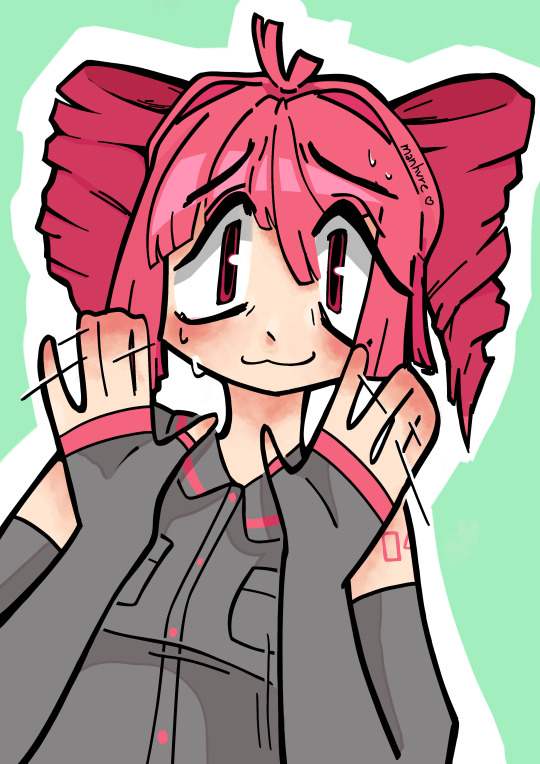
TETOTETOTETOOOOOOO o((>ω< ))o (((o(*゚▽゚*)o)))
#kasane teto#teto utau#utauloid#teto fanart#teto kasane#teto synthv#vocaloid fanart#artists on tumblr#artwork#sketch#beginner artist#digital art#digital illustration#my art#fanart#vocaloid#vocal synth#project diva
203 notes
·
View notes
Text
Dream Witchcraft: Casting Spells in Your Sleep
Your dreams are not just random—they’re portals, messages, and magical realms. Dream magic is the practice of working with your dreams for insight, healing, and manifestation. Sleep becomes your spell.
1. Create a Dream Space
Cleanse your room. Place amethyst, mugwort*, or lavender by your bed. Use soft lighting or a white candle to calm the energy before sleep.
2. Keep a Dream Journal
Write everything—images, feelings, symbols—immediately upon waking. Patterns will form, and messages will become clearer.
3. Set Intentions Before Sleep
Whisper a desire or question before bed:
“Show me what I need to know.”
“Tonight, I visit my inner temple.”
4. Work with Moon Phases
• Full Moon – prophetic dreams
• New Moon – dream planting (manifestation)
• Waning Moon – dream release (letting go)
5. Lucid Dreaming & Astral Travel
Practice awareness in your dreams. Use sigils or symbols to guide and protect you. Place a protective charm near your bed before attempting deeper dream work.
Dreams are not just stories—they’re spells in disguise.
Masterlist | linktree | Patreon

#dream magic#dream witchcraft#witchblr#witchcore#witchcraft#witchlife#beginner witch#witch tips#white witch#grimoire#spirituality#book of shadows#dream journal#lucid dreaming#astral travel#astral projection
72 notes
·
View notes
Text
Hello I want to bring your attention to your own blog
Most of the tarot reader's blog have gotten 'mature content label' which is resulting into hiding of your blog , posts not coming in tags and blog getting blurred hence overall low engagement

This is what coming at everyone's blog which have gotten their content labelled unless you've allowed the mature content
What's the solution? check your whole blog and private those labelled posts , remove the pics and be careful about posting images in pacs and moodboards because Tumblr is literally marking everyone's blog blindly
also even if they review your content that 'label' will be forever at your post it can't be removed means no benefits no engagement on that post in future too ✨
Some tarot reader's blog that I noticed facing this problem @winisayswhat @tarotwithavi @mweothe11e @laur1221 @tarotwithavi @thetarotyapper @the-tarot-witch22 @redwinewhiteroses @kiddotarot @theladybrownstarot @uyuforu @pisceantarot @galene-gothic @clairdelunetarot @the-cosmic-cauldron @tiashasworld @cadyflowers and many more !
I thought it happened with me only and was very frustrated but then I noticed most of the blogs were marked .
I hope this post is helpful for you in some way and if anyone have solution please share with all of us 💞🫶🏻
Thank you for reading! 🙏🏻
#pick a card#pick a pile#pick a picture#astrology#astro notes#astro community#astro observations#vedic astrology#astro placements#tarot reading#future spouse pick a card#future spouse reading#tarot pac#tarot pick a card#tarot pick a pile#tarot project#tarot paid readings#tarotblr#tarot blog#tarot beginner#tarotdaily#tarot deck#tarot divination#tarot witch#tarotista#tarotlife#tarot requests#numerology#astrology chart#astrology signs
67 notes
·
View notes
Text
Green Coat update: Jazzed up Butterfly #2, started Butterfly #3


Oh, and also! The cross-stitch patch collection these are from are now up on Etsy!

And yeah, that's the Etsy where ALL embroidery patches are 40% off right now. Stick 'em on, wash 'em off, look beautiful.
#green coat project#embroidery#haberdashery#visible mending#embroidery for beginners#cottagecore#sewing#diy embroidery#small business on tumblr#artists on tumblr
124 notes
·
View notes
Text
Some GFX art, cause why not!!!
It's from most recent to first.
(Man I love when my oc edit is just in the corner)
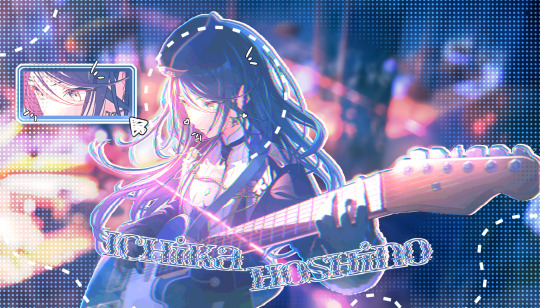

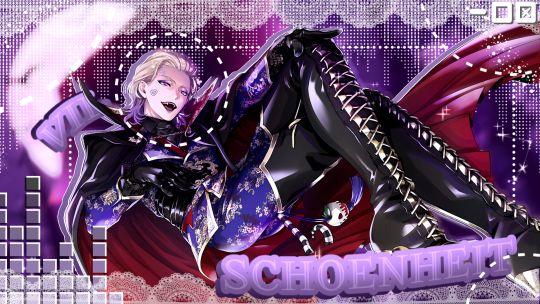


Why did it take 12 hours for Idia, cause it's so basic.
Mizuki Akiyama is next...
#disney twst#twisted wonderland#gfx#pjsekai#prsk#pjsk ichika#ichika hoshino#twst#twst wonderland#project sekai#idia shroud#twisted wonderland idia#twst idia#vil schoenheit#twst vil#twisted wonderland vil#art#beginner artist#artists on tumblr#artwork#digital art#my art#im so tired#unmotivated#im tired#yandere twisted wonderland#yandere twst#gfx artist#pjsk mizuki#project sekai mizuki
72 notes
·
View notes
Text
Hello Internet!
I’ve been working on a project that involves compiling a bunch of information on sewing and mending, so I’m putting it out to the world so that more people can see and benefit from it!
The best way I could figure to do this was to attach PDF links of my guides that I made, so sorry if there are technical issues with accessing them, I’m still trying to figure out how to attach them properly
This one goes over basic handsewing stitches and mending techniques
And if you know a bit about sewing and how to use a sewing machine, but are still figuring out different techniques and things, I’ve compiled a list of a variety of beginner friendly sewing projects, with instructions and pictures!
Hope this is helpful for someone!
102 notes
·
View notes
Text
2025 IndyCar Primer
With St Pete 8 days away its time to unveil the 2025 IndyCar Primer!
Just like last season, this will be a living document. As things change over the season, such as sponsorships or possible driver changes, I will update it!
Also, the same disclaimer applies: I am biased and I make some jokes throughout. This is not an impartial document! Also, this isn't all that serious! Its surface level information for the most part, and designed to be a good way to cover a lot of basics! If there is anything anyone wants me to add, please let me know!
If there are any glaring mistakes please let me know so I can fix them, and if you have any questions I am more than happy to answer them or go more in depth as needed!
#also if you just want to talk about it!!! I am also happy to do that!#or talk indycar in general!!!#indycar 2025#indycar primer#indycar beginners guide#indy 2025#data and information projects#reference material
51 notes
·
View notes
Text



#personal#she is finally home yay#the bonbonribbon sticker is there for a purpose#it's in the C note#in the middle C key#so I know where it is C everytime I practice#it's a beginner tip#the tags:#airi momoi#keyboard#more more jump#project sekai#colorful stage#plushies#nesoberi#kawaii#kawaii blog#kawaii aesthetic#sanrio#sanriocore#pinkcore#soft pink#pastel pink#pink aesthetic#pink blog#girlblogging#this is a girlblog#this is what makes us girls#keyboard music
64 notes
·
View notes
Text

MDZS project
Sketchbook fully dedicated to mdzs
( ╹▽╹ )
#mdzs#mxtx mdzs#mdzs fanart#art#traditional art#beginner artist#wei wuxian#sketchbook#art project#art wip#wip
51 notes
·
View notes
Text
DESERT DUO MAP CALL NOW OPEN!! It allows any design (regardless of species) for Grian and Scar, as long as they stay within the color palette!
youtube
#desert duo#map call#multi animator project#beginner artists welcome#map call open#life series#art#trafficblr#wild life smp#grian#hermitblr#traffic smp#hermitcraft#3rd life#double life#wild life#secret life#gtws#gtwscar#gtws fanart#gtws hermitcraft#goodtimeswithscar#grian fanart#goodtimewithscar fanart#trafficlife#traffic series#traffic life#Youtube
39 notes
·
View notes